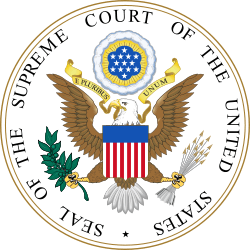Nixon v. United States
| Nixon v. United States | |||||||
|---|---|---|---|---|---|---|---|
|
| |||||||
| Argued October 14, 1992 Decided January 13, 1993 | |||||||
| Full case name | Walter L. Nixon, Petitioner v. United States, et al. | ||||||
| Citations | |||||||
| Argument | Oral argument | ||||||
| Prior history | 744 F.Supp. 9 (D.D.C. 1990), aff'd, 938 F.2d 239 (D.C. Cir. 1991), cert. granted, 502 U.S. 1090 (1992) | ||||||
| Subsequent history | None | ||||||
| Holding | |||||||
| The contention that Senate committees appointed to gather evidence in an impeachment trial are unconstitutional is nonjusticiable, because impeachment is a political question. | |||||||
| Court membership | |||||||
| |||||||
| Case opinions | |||||||
| Majority | Rehnquist, joined by Stevens, O'Connor, Scalia, Kennedy, Thomas | ||||||
| Concurrence | Stevens | ||||||
| Concurrence | White, joined by Blackmun | ||||||
| Concurrence | Souter | ||||||
| Laws applied | |||||||
| U.S. Const. Art. I, Section 3, Clause 6 | |||||||
Nixon v. United States, 506 U.S. 224 (1993),[1] was a United States Supreme Court decision that determined that the question of whether the Senate had properly tried an impeachment was a political question and could not be resolved in the courts.
Facts
In this case, Chief Judge for the United States District Court for the Southern District of Mississippi Walter Nixon was convicted of committing perjury before a grand jury but refused to resign from office even after he had been incarcerated. Nixon was subsequently impeached by the US House of Representatives, and the matter was referred to the Senate for a vote on Nixon's removal. The Senate appointed a committee to hear the evidence against Nixon and later report to the body as a whole. The Senate then heard the report of the committee and voted to remove Nixon from office. Nixon contended that this did not meet the constitutional requirement of Article I for the case to be "tried by the Senate."
Decision
The majority opinion (the court's decision was unanimous, but four separate opinions were published) held that the courts may not review the impeachment and trial of a federal officer because the Constitution reserves that function to a coordinate political branch. Article I. Sec. 3 of the Constitution gave the Senate the "sole power to try all impeachments." Because of the word "sole" it is clear that the judicial branch was not to be included. Furthermore, because the word "try" was originally understood to include factfinding committees, there was a textually demonstrable commitment to give broad discretion to the Senate in impeachments.
Furthermore the Framers believed that representatives of the people should try impeachments, and the Court was too small to justly try impeachments. Also, the judicial branch is "checked" by impeachments so judicial involvement in impeachments might violate the doctrine of separation of powers.
The Court further ruled that involving the judiciary would prevent finality without clear remedy and bias post-impeachment criminal or civil prosecutions, which the Constitution explicitly allows.
Justices White, Blackmun and Souter concurred but voiced concern that the Court was foreclosing the area for review. While they found that the Senate did all that was constitutionally required, they were concerned that the Court should have the power to review cases in which the Senate removed an impeached officer summarily without a hearing, or through some arbitrary process, such as "a coin toss."
An important feature of this case is how it diverges from Powell v. McCormack. In Powell, a grant of discretionary power to Congress was deemed to be justiciable because it required a mere "interpretation" of the Constitution.
